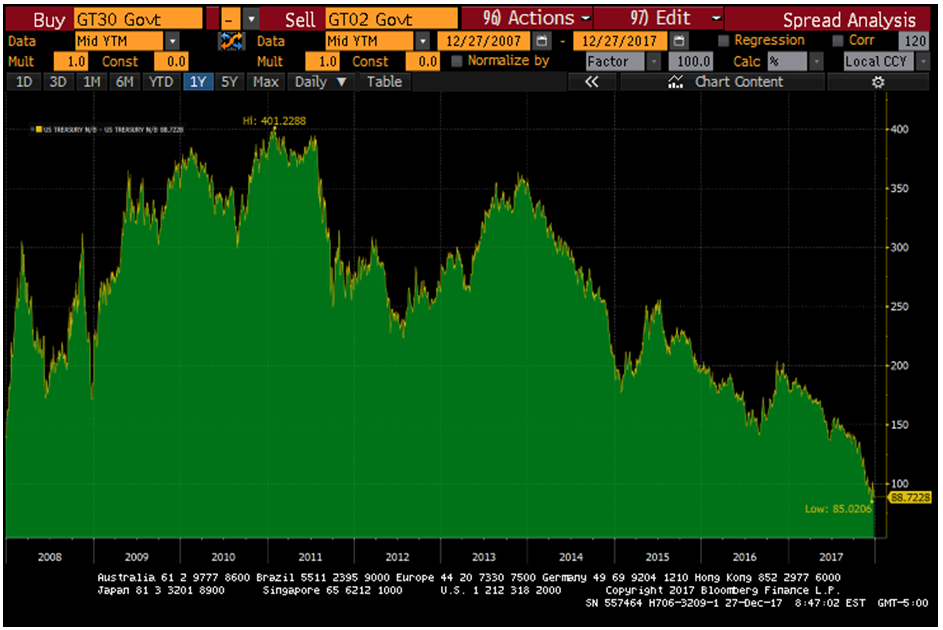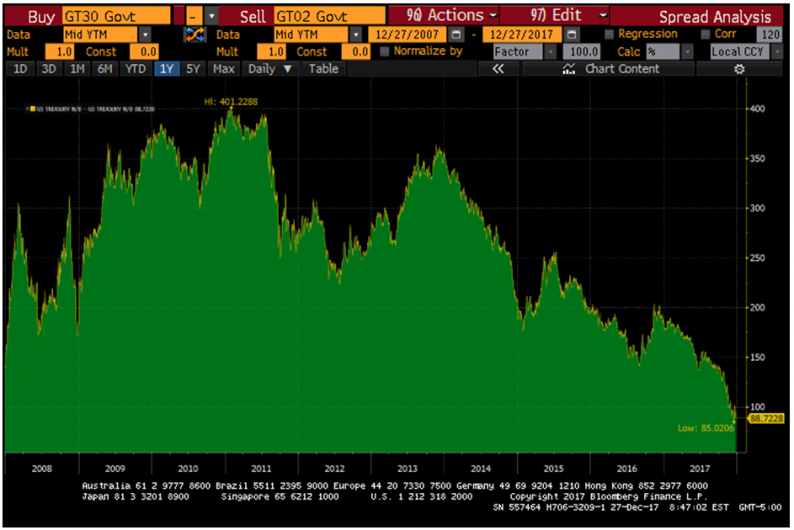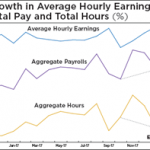The fourth quarter of 2017 continued to produce records in the equity market, while the yield curve in the fixed-income market continued a flattening trend. The largest movement in yield was on the short end, as short-term rates continue to rise. As of December 20th, the 1-year and 2-year Treasury yields increased 42.6 and 41.9 basis points respectively, to 1.72% and 1.905% since the beginning of the quarter. The 10-year Treasury yield is only up 9.1 basis points to 2.425% while the 30-year Treasury yield is down 9.9 basis points to 2.761% for the same period. The main factor driving the flattening yield curve continues to be the Federal Open Market Committee’s (FOMC’s) push to raise short-term interest rates. The following graph shows that the spread between the 2-year and 30-year Treasuries reached a 10-year low on December 15th, when a buyer of Treasuries could only pick up an additional 85 basis points of yield for extending maturity to 30 years rather than buying a 2-year Treasury.

Source: Bloomberg
At the December 13th FOMC meeting the Fed raised the fed funds target rate 25 basis points to a target range of 1.25–1.50%. After holding rates steady at the third-quarter meeting to announce the roll-off of their balance sheet, the Fed raised rates for the third time in 2017 and for the fifth time in this hiking cycle. The Summary of Economic Projections “dot plot” continued to show three hikes for 2018 and just over two for 2019. The statement accompanying the meeting remained in line with forecasts from the third-quarter meeting. Growth has remained strong, with two consecutive quarters of above-trend GDP advances. The statement also revised the labor market outlook from “some further strengthening” to “strong,” as the unemployment rate approaches historic lows at 4.1%. The more hawkish tone of the statement points to positive near-term economic growth and continued strong equity markets.
Over the last few weeks of 2017, we have been presented with an opportunity to take advantage of relative cheapness in the tax-free municipal market by doing crossover buying into taxable accounts. Last year we were given this opportunity with the “Trump selloff,” as yield skyrocketed after Donald Trump was elected president and tax-free municipals came to market at Muni/Treasury yield ratios of 130–140%. This year a similar opportunity has presented itself with the tax bill. The tax bill threatened to eliminate Private Activity Bonds and advance refunding, which caused issuers to rush to market to refund old debt at lower yields. This rush to issue bonds has once again blown out the Muni/Treasury ratio to the 140–155% range. We believe this situation represents a relatively inexpensive (and potentially defensive) opportunity. You can read more about the tax bill and how it is impacting the municipal market in John Mousseau’s piece “The Muni Take on the Tax Bill (Round Two).”














Leave A Comment